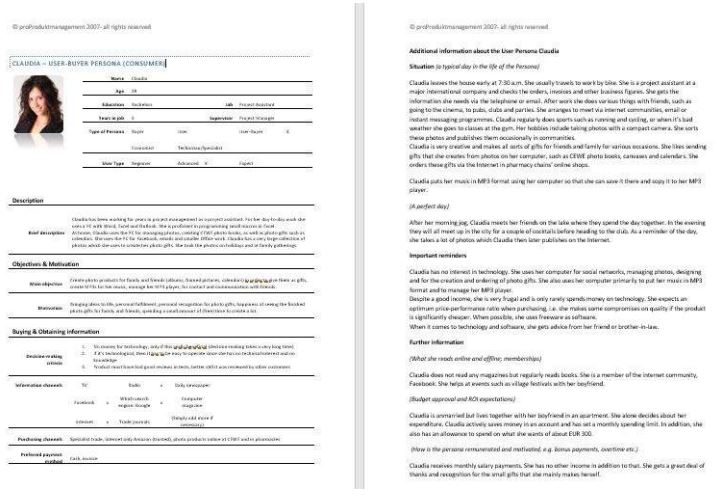Already in the strategic part of product management, we asked ourselves: What is a persona? There, we developed the buyer persona in order to be able to convey the 4Ps of the marketing mix in a more understandable way in everyday life.
Following a similar approach with the user persona exampleyou have the user persona definition: We describe for whom we are developing the product. The user persona reflects the market experience of the Concept Developer/Designer and that of Product Management. The Concept Developer/Designer and Product Architect develop solutions to the problems of personas. For this reason, the user persona should be developed in collaboration between Product Management, Concept Developer/Designer and Product Architect.
User persona goals
The following objectives are to be achieved with the user persona:
- Time saving by simplifying communication
- Should enable us to develop empathy
- Reflection of the stereotypical user behaviour
- Creation of a common understanding for a user group
- Help with design decisions
You may also remember our statement for the user persona:
Solve problems for the user persona.
As well as the one for the buyer persona:
Explain the added value for the buyer persona.
User persona example Claudia
Our persona example Claudia, which we use for our product SelfBackup in our free book Technical Product Management is both a user persona and a buyer persona of a product.
Because there can be overlaps, you should develop the user persona in the team together with the Concept Developer/Designer and Product Architect.

The Strategic Product Managers alone are responsible for the development of the buyer persona, since they can derive strategies with their help, such as sales and communication strategies. The buyer persona also helps during the entire Go-to-Market. You will get more detailed information on this persona in the "Strategic Product Management” section.
What information is important for a user persona?
Let’s take the Claudia persona first for our SelfBackup example. Claudia needs a solution to regularly, automatically and wirelessly back up her photos. She wants to simply open her laptop and automatically back up photos as well as other data but doesn’t understand anything about special technologies, such as NAS for example.
First of all, we have the following information about our Claudia persona:
- She studied for a BA in Economics
- She works in Project Management at Deutsche Telekom
- She uses a laptop
- She takes photos on holiday and at parties
- She uses her computer privately for:
- Photo editing and management, design of photo albums and photo gifts
- Social networks, email, Office
Is the above information enough for you to determine any level of expertise?
Does the following information help you to fine-tune things further for Claudia?
- Shoe size 38
- Lives in Bamberg
- Drives a VW Golf
- Likes to go on beach holidays
Or are these unnecessary? Please decide for yourself.
General Information on user persona
A user persona should always include the following general information:
- Name
- Photo
- Demographic information: gender, age, marital status …
- Education, profession, (technology) skills, level of expertise
- Background: family, hobbies, likes, dislikes
- Goals, desires, expectations (of the product)
In order for the user persona to be quickly understood and also used, the following should be kept in mind during their creation:
- Only as much information as necessary
- Improve and expand information if it becomes necessary
- A maximum of 5 different personas, as otherwise the overview is lost and the communication becomes too complex
Level of Expertise
Now we want to talk about what is meant by the Level of Expertise, which has been mentioned several times.
In which two groups is the technical knowledge around the product most frequently discussed during product development?
Most of the discussions will be held by these two groups:
- Beginners
- Experts
The reasons why this is so, are simple.
- The “Beginners” group often get in touch with Product Support because they have questions about the use of the product.
- The “Experts” group also get in touch with Product Support and with Sales, because they often want specific features which are currently not included in the product.
Unfortunately, the “normal users” are often forgotten in the discussions about the user behaviour. This group uses the product without having to contact Support because they get to grips with the product and the existing functions are sufficient.
If you compare the distribution of customers in the three groups, you will notice that the normal users are predominant.
This insight is easily illustrated in a diagram. On the x-axis (x=0 -> infinite knowledge of product) going towards the right you have Beginners, Normal Users and Experts. On the y-axis (y=0 -> infinite users) you plot how often the respective users appear. This results in a curve similar to the Gaussian distribution curve (bell curve), whereby the Normal Users are located under the apex of the maximum.
The Level of Expertise, within the personas, describes the belonging to one of the three groups Beginners, Normal Users and Experts.
Read the continuation: Interviews with the right persona
This article User persona example and definition is an excerpt from our textbook Strategic Product Management, which is available for free download.
About the author
Frank Lemser is a trainer and founder of proProduktmanagement. He has been a market-driven evangelist since the beginning of the 2000s and since then has also been methodically involved with product management. He has developed the Open Product Management Workflow™, numerous tools for product managers, written and published books free of charge and was involved in the development of the Product Management Dashboard for JIRA. His personal goal is to solve many everyday and work problems for product managers, to professionalize and simplify the work for product managers.




















